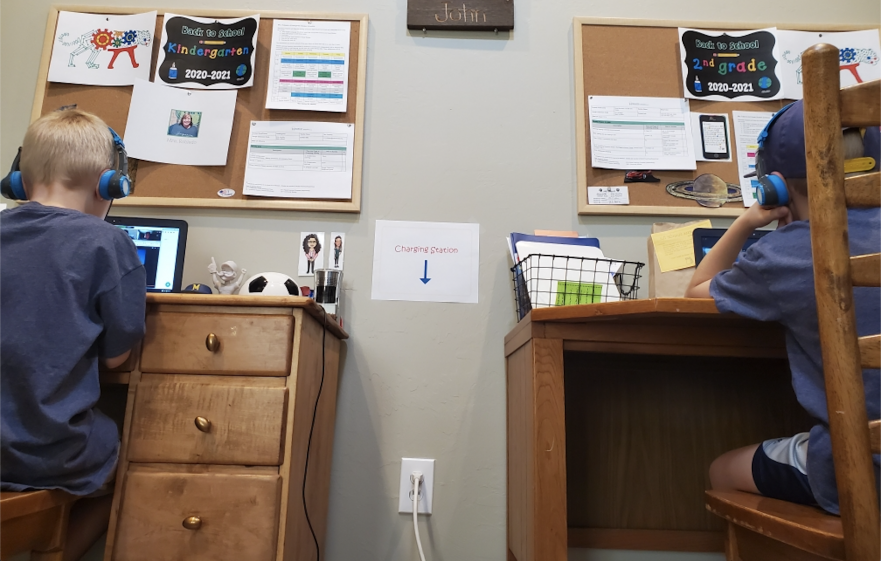I was thrilled to begin hybrid instruction when my district decided to offer that option to families following fall break. I couldn’t wait to see my students in person. I was excited to see them interacting with their peers in the classroom and on the playground.
However, as I continue to navigate the hybrid model I realize more and more that hybrid instruction is less than ideal, especially for young children. I am in no way downplaying the spread of COVID-19 or the severity of the medical complications associated with the virus, many unknown at this time. Still, I believe it’s time that more school districts offer families the option to return to 5 day in-person instruction, especially for elementary aged children.
Educating children involves a partnership with their families and I have had many open, honest conversations with families so that I can understand their perspectives and advocate for their child’s needs. One parent, Kristin Brandstaetter, shared:
I was hopeful and know that our teachers have worked so hard to get a learning model in place that, in theory, is great for our kids and a “safe” return. But hybrid learning is anything but easy in our home. In fact, the remote learning model that was in place was better than the hybrid model. My children receive less instruction than in remote learning, provided by teachers who are working twice as hard to provide it to them. And my children spend more time learning from a computer, than they do from their teachers.
We should be prioritizing the return to school, for those families who choose to do so, in order to provide our children with not only a solid education, but also the social-emotional skills that they are missing out on. My children (ages 6 & 8) experience more anger, frustration, and anxiety than they ever have before. And while they are doing “okay” with their hybrid learning, I truly feel that they are missing out on the very important elements that are necessary for their learning and development.
Myself along with many teachers and families believe that school districts should offer the option of 5 day in-person learning for the following reasons:
- Children need routine. They need to know what to expect on a day to day basis. Children thrive with predictability. Hybrid learning feels helter skelter for many students. Is it a school day or am I learning from home today? Will I get to see kids my age and play or will I have to occupy myself on my tablet when I’m done with my work? Children experience more success when they have a predictable schedule- school Monday through Friday, then the weekend. Teachers and parents know this to be true through and through.
- All children are getting further behind. Arizona students in many public districts have not had “normal” 5 day a week instruction for eight months. That is a long time. They have now missed important grade level standards in not one but two grade levels. Teachers are doing everything they can to assess students’ strengths and areas of need and create high quality engaging instruction but…
- …The gap between students is widening. Both remote and hybrid instruction provide inequitable access to education. We would like to think each child is home with an adult that loves and cares for them, is patient as they ask for help, and can guide them through school work that they don’t understand. But the reality is many parents are working, many kids are with an aunt, uncle, grandparent, or friend who is also attempting to work from home. Some children are home with an older sibling attempting to do their best with their classes.
- Two days of in person instruction per week is not sufficient. I have been teaching my students in a hybrid model for three and a half weeks. I have seen each student seven times. SEVEN. I have to make every moment I’m with my students count, and even when I do, there are still things I didn’t get to- struggling students who I didn’t have time to work with in a small group or high readers who don’t get enrichment because there is not enough time in the day.
- Students’ mental health and wellness is at risk. There has been an increase in mental health problems such as depression and anxiety in kids and sadly, more suicides already this year than past years.
We always say children are our future. It’s time that we treat them as such and give them the high quality education they deserve in the form of 5 day in-person instruction.
DISCLAIMER: I know there are many obstacles in the way of a full return to school, but I hope, for the sake of students, that we can move in that direction sooner rather than later.










Comments 5
I agree that hybrid instruction may not be enough, but my experience with returning to school 5 days a week also feels like it is not enough! It is hard on our young learners to learn behind plastic dividers, work independently since we are not allowed to do partner grouping right now, and wash their hands 7 times a day which takes an hour out of our day. 2020 is a hard year. I hope that we can return to normal as soon as it is safe to for the sake of both students and teachers.
So many dilemmas! I do feel that even returning for five days of school is not a “return to normal.” This whole thing has been so hard on everyone. We all want it to be okay, and there are no clear answers about how to accomplish that (even if it is possible anytime soon.) This blog and your comment set me right back reflecting on all of this…
Thank you for sharing your perspective. We also have been on full return since October for our elementary schools. Although it has not been without issue, it has been positive. I am absolutely concerned with the outside elements and each community’s need to focus on the importance of education. Schools can only stay open when others cooperate and work to keep cases low. Unfortunately, I don’t see this happening. If school is as important as we stated it was, we all must work together to support schools staying open.
Amen.
I like that you add the qualification “at least for elementary students.” I also don’t want to downplay the risks for students and staff, but except for the youngest of students, the possibility of managing and maintaining an orderly school day with mitigation procedures in place seems much more do-able at the elementary level (the ability to cohort students, break up lunches more, etc.)
At junior high and high school, the scheduling and mixing of students, combined with normal teenage behaviors and dispositions, makes it much more difficult to manage student-to-student contact and mask policies throughout the day. I think we are doing a pretty good job, but still…
I also agree with the idea that when things were completely remote, students got more attention and direct help from the teacher. When so many things are juggled around through the week, one of the most practical immediate solutions is for teachers to put all work onto the learning platform, and I can totally relate to that feeling that students are “learning from a computer.” It’s ironic that going back in person part time created that dynamic, but it was like that for my own students as well (high schoolers).